ABOUT PEPPERS
Better Late than Never
Cold has finally gotten the better of my pepper plants. Two below freezing nights a month ago started their demise, and two more during the last few nights finally finished them off for the season. Not the fruits, though, plenty of which are piled and spread out in trays and baskets in the kitchen.
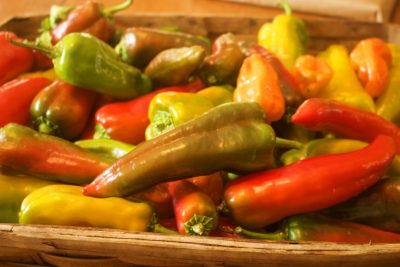
Outdoors, fruits weathered the below freezing temperatures well. They’ve been shielded from the full brunt of cold by their canopies of increasingly floppy leaves. Also, fruits of plants are higher in sugars than are the leaves. Thinking back to high school chemistry, I recall that any solute, such as sugar, lowers the freezing point of the solution. So pepper fruit cells can tolerate more cold than pepper leaves.
Even with the plants dead outside, the pepper season isn’t over here. The season has been greatly extended by harvesting and bringing indoors sound, green peppers showing any bit of red — or yellow if that’s the pepper’s ripe color. Sitting in trays and baskets in the kitchen, these mostly green peppers have been ripening, depending on when they were harvested and how long they’ve sat, to fully red or yellow color, when they are most flavorful (to me).
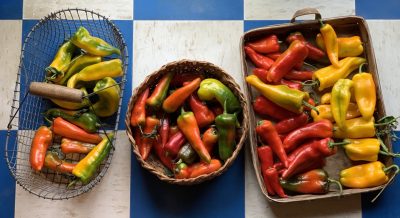
For some reason, perhaps the heat interfering with pollination, peppers started ripening later in the season than usual. The present and the past few week’s abundance of them makes up for the late start.
Thank You C2H4
For the peppers’ morphing from green to red or yellow, I have to thank, in large part, a simple gas made up of just two atoms of carbon and four atoms of hydrogen. It’s ethylene, a plant hormone. Most plant and animal hormones are much more complex molecules.
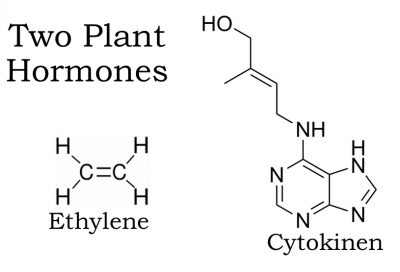
Ethylene is produced naturally in ripening fruits, and its very presence — even at concentrations as low as 0.001 percent — stimulates further ripening. The ethylene given off by ripe apples can be used to hurry along ripening of tomatoes, by placing an apple in a closed bag with the tomatoes.
Banana, apple, tomato, and avocado are among so-called climacteric fruits, which undergo a burst of respiration and ethylene production as ripening begins. These fruits, if picked sufficiently mature, can ripen following harvest.
Peppers, along with “figs, strawberries, and raspberries are examples of non- climacteric fruits, whose ripening proceeds more calmly. Non-climacteric fruits will not ripen after they’ve been harvested. They might soften and sweeten as complex carbohydrates break down into simple sugars, but such changes might be more indicative of incipient rot rather than ripening or flavor enhancement.” Or so they say. And, I admit, I’ve said; that quote is from my book The Ever Curious Gardener. (The rest of the section about ethylene in my book is correct.) They and I were wrong.
So, I’ve learned two things. First of all, pepper do ripen well after harvest, not only to a bright color but also to a delicious flavor. And second, further reading has revealed that hot peppers, but not sweet peppers, are, in fact, climacteric fruits.
What about semi-hot peppers? Or non-hot hot peppers? (Read on.)
Hot and Not
I did also grow some semi-hot peppers this season. Roulette is a variety billed as resembling “a traditional habanero pepper in every way (fruit shape, size and color, and plant type) with one exception – No Heat!” Roulette had an interesting flavor that I both liked and didn’t like (mostly liked), and occasional ones did have some heat to them, but that might have been due to their proximity to . . .
Red Ember is billed as an early ripening hot pepper with “just enough pungency for interest.” It definitely caught my attention when I bit into one! Call me a wimp, but I thought it was fiery hot.
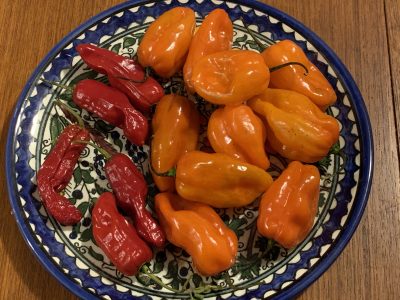
Peppers, Red Ember and Roulette
In my previously mentioned book, The Ever Curious Gardener, I also explored flavor in fruits and vegetables and, briefly, hotness in hot peppers. “Studies have been done with peppers, focusing specifically on their hotness, which, to muddy the waters, stems from not one, but from a whole group of compounds, capsaicinoids, mostly capsaicin and dihydrocapsain. Hotness in peppers was found to depend on the variety, the environment, and the interaction between variety and environment, with smaller fruited peppers less influenced by vagaries of the environment. Usually, but not always, a pepper will have more bite if plants are grown with warmer nights, with colder days, with just a little too much or too little water, or with fertility imbalances; increased elevation elicits the fiercest bite. Basically, with any sort of stress.”
Uncommonly hot temperatures this summer may very well have turned up the heat in Red Ember and put some heat in Roulette.

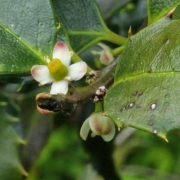
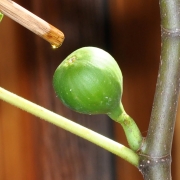

Perfect timing, thanks! We’re bringing in our peppers tonight, and have previously given away the waay too abundant unripe ones to a friend, since we can’t eat the green ones here. So delighted to know we can ripen some of them up!
I put your latest title on my holiday wish list. (Which now has one entire item.) 🙂
I could eat the green ones, but don’t. They taste totally different from ripe ones, in my opinion far inferior. I pick them out of food in restaurants (from my own plate, not other’s 🙂 )
Will previously refrigerated greenish peppers ripen up when removed from this type of cold environment? Wondering if I could enjoy the ripe peppers over a longer period this way.
Interesting question. My guess is that temperatures around 50 degrees would be better than refrigerator temperatures, which are around 40 degrees. Then the challenge is to keep them from drying out without promoting rot. Use only sound peppers.
I just went out this morning and harvested a couple of dozen peppers before tomorrow’s forecasted frost. This is the best pepper year I have ever had. I don’t even love peppers but definitely don’t want them to go to waste. How can I preserve them and how can I use them. Thanks.
Roast and freeze. Or just chop and freeze (no blanching necessary.)
I started making a yearly batch of hot pepper mash or hot pepper sauce. Admittedly a fairly mildly hot sauce as I can’t tolerate the extremely hot peppers. It does give me a chance to use some of my too-hot-to-me peppers in a way that I can stomach.
Lee:
Now that you harvested the peppers what do you do with them?
Eat them!! Mostly fresh but some get roasted and frozen.
Thank you for your quick response Lee. I really appreciate it.
Just had stuffed peppers tonight. Will pickle the little ones
What is the best environment/temperature to ripen the harvested peppers? I have a wonderful glut this year and have been roasting and freezing like mad, fermenting, and also gorging on Romesco sauce and muhamarra.
My guess is slight cool and fairly humid. Which is why soon after writing the post, pepper ripening wasn’t so good anymore. Temperatures turned cold outside so the woodstove was cranking away, making the house warmer and drier than previously. I suppose if I was really a pepper-head I would keep my house uncomfortable for me but comfortable for the ripening peppers.
Muhammarah!!!
Next best thing to ambrosia!
Enjoy!
My Armenian cousin, who makes the best in the world, is always welcome to any potluck…
We grew jalapenos, serranos, Hungarian yellow wax, and habanero peppers this year. The Hungarian and habaneros were mildly hot, the jalapenos hot, and the serranos were blow your head off hot. All were grown in close proximity to each other.
In addition to freezing our bounty we pickle them and can them, giving away some as gifts. My husband also made hot sauces and pepper relish. It is so nice to enjoy them throughout the winter and up until the next year’s harvest.
Ironically, even though we have had great success with growing hot peppers, and sweet peppers never do well. We have yet to figure out why this is so.
Hot peppers also seem easier for me. One reason might be if they have smaller fruits. Smaller fruits generally ripen faster. Also, a few species yield edible peppers, so genetic differences also account for environmental tolerances and ripening times.
Thanks very much for your post. I learned more about peppers than I knew before. I’m not a great fan of really hot peppers, Jalepenos are about as much as I can stand, but I enjoy the taste of peppers quite a bit.
I just went out and harvested the last of my booming string beans. They are sweet and crisp – not usual for almost November! I appreciate your comment about heat possibly delaying pollination;-my Mexican sour gherkins yielded like crazy all summer and have been wonderful to quick-pickle for a pop of flavor in many soups, but the green beans, several types, simply didn’t start making beans till way later in the summer. Temperature aside, I believe the days grow too short by when? mid-November? – for any more growth of anything. What’s your understanding, Lee?
It seems to me that growth dramatically slows, even in the cool greenhouse, after early October.
I think you miscounted your H’s.
Eegads! You’re right. How embarrassing. (And I was once a chemistry grad student — although I never liked organic chemistry.) Thanks for the correction.
My poblano pepper plants were grown from seed and took awhile to bear fruit.They now have plenty of flowers and some small peppers but I doubt that they will grow given that the weather has turned colder. Is there any water the plants can be preserved for replanting next year? I know that geraniums can be saved for transplanting. How about Gerber daisies? Thanks
You could dig them up, pot them up, and keep them alive in a sunny window through winter. Probably.